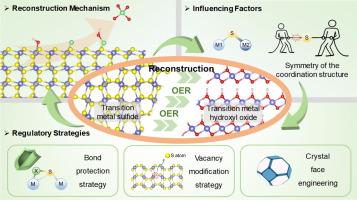Theoretical design rules for the reconstruction of transition metal sulfides during oxygen evolution reactions
IF 14.9
1区 化学
Q1 Energy
引用次数: 0
Abstract
During the oxygen evolution reaction (OER), reconstruction of transition metal sulfides (TMSs) is inevitable. However, the lack of a clear theoretical understanding of this process has impeded the development of effective reconstruction regulation strategies. In this study, we first explored the reconstruction mechanism of CoS2 during OER from the perspective of electronic structure and identified two possible pathways: the OH-assisted mechanism and the O-assisted mechanism. Further verification showed that these mechanisms are universally applicable to other TMSs (e.g., FeS2). Based on the reconstruction mechanism, we investigated the basic reasons for the influence of various regulation strategies, such as vacancy modification and facet engineering, on the reconstruction ability. This verified that the method of analyzing the change in the reconstruction ability of catalysts based on the reconstruction mechanism has a high degree of applicability. Importantly, we proposed a core regulation strategy: the coordination symmetry regulation strategy. Specifically, by breaking the symmetry of the surface coordination environment of TMSs (such as introducing heteroatom doping or strain), the reconstruction process will be facilitated. Our findings provide a comprehensive mechanistic explanation for the reconstruction of TMS catalysts and offer a new idea for the rational design of OER catalysts with controllable reconstruction capacity.

析氧反应中过渡金属硫化物重建的理论设计规则
在析氧反应(OER)中,过渡金属硫化物(tms)的重构是不可避免的。然而,对这一过程缺乏清晰的理论认识阻碍了有效重建调控策略的发展。本研究首先从电子结构角度探讨了CoS2在OER过程中的重构机制,确定了oh辅助机制和o辅助机制两种可能的途径。进一步的验证表明,这些机制普遍适用于其他tms(例如FeS2)。基于重构机制,探讨了空位修饰、面形工程等调控策略对重构能力影响的基本原因。这验证了基于重构机理分析催化剂重构能力变化的方法具有高度的适用性。重要的是,我们提出了一个核心调控策略:协调对称调控策略。具体来说,通过打破tms表面配位环境的对称性(如引入杂原子掺杂或应变),将有利于重建过程。本研究结果为TMS催化剂的重构提供了全面的机理解释,并为合理设计具有可控重构能力的OER催化剂提供了新的思路。
本文章由计算机程序翻译,如有差异,请以英文原文为准。
求助全文
约1分钟内获得全文
求助全文
来源期刊

Journal of Energy Chemistry
CHEMISTRY, APPLIED-CHEMISTRY, PHYSICAL
CiteScore
19.10
自引率
8.40%
发文量
3631
审稿时长
15 days
期刊介绍:
The Journal of Energy Chemistry, the official publication of Science Press and the Dalian Institute of Chemical Physics, Chinese Academy of Sciences, serves as a platform for reporting creative research and innovative applications in energy chemistry. It mainly reports on creative researches and innovative applications of chemical conversions of fossil energy, carbon dioxide, electrochemical energy and hydrogen energy, as well as the conversions of biomass and solar energy related with chemical issues to promote academic exchanges in the field of energy chemistry and to accelerate the exploration, research and development of energy science and technologies.
This journal focuses on original research papers covering various topics within energy chemistry worldwide, including:
Optimized utilization of fossil energy
Hydrogen energy
Conversion and storage of electrochemical energy
Capture, storage, and chemical conversion of carbon dioxide
Materials and nanotechnologies for energy conversion and storage
Chemistry in biomass conversion
Chemistry in the utilization of solar energy
 求助内容:
求助内容: 应助结果提醒方式:
应助结果提醒方式:


